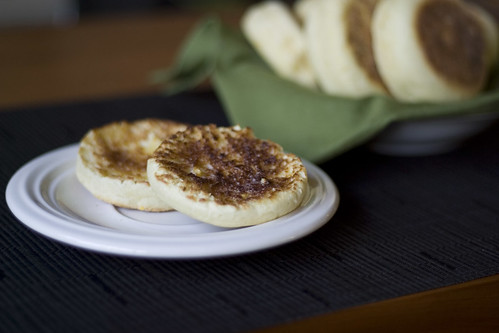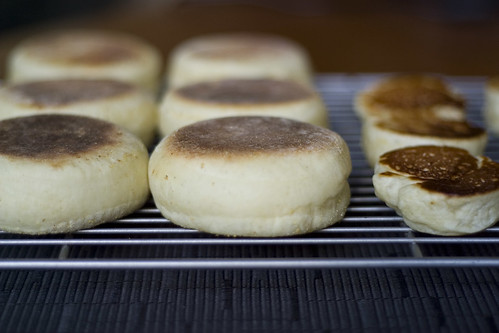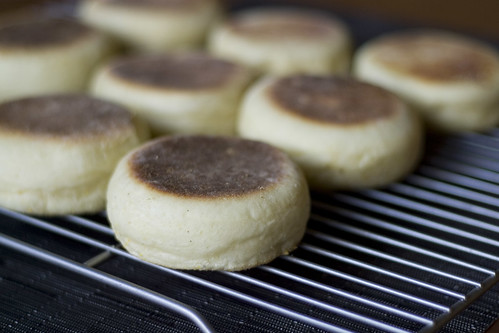
I don't remember what it was that launched my recent search for a great English muffin recipe. I like English muffins, or "Eng muffs" as we referred to them when I was a child, but I haven't eaten (let alone bought) them in years. They are not exactly an obsession of mine. Yet something in the last couple of weeks put English muffins into my head, which tapped into eight or nine years' worth of English muffin deprivation, and suddenly I desperately wanted an English muffin. Of course, it wasn't good enough simply to go out to the store and buy some, I had to make them. And so my quest for the perfect homemade English muffin was born.
To be honest, I still haven't found it. I've tried three different recipes, and each one was inadequate in some way (or many ways). The first, well, perhaps the less said the better--even though it came from a trusted source. The second came from another fairly trusted source, Alton Brown, but the muffins came out small and lackluster, and hardened substantially only a few hours out of the skillet. The flavor was acceptable, though, and the recipe did have one thing going for it: the muffins had great nooks and crannies. 
Enter the third recipe, and my current favorite, from Bernard Clayton's New Complete Book of Breads. That's it up on the left there; the ones on the right are the results of Alton Brown's recipe. I ask you: which would you rather toast and spread with butter and jam (or sandwich around an egg, or a piece of cheese) for your first meal of the day? Still, for all that they might look like beautiful English muffins, they aren't perfect: despite being delightful in almost every way, they lack nooks and crannies. Split open (with a fork, as they should be), the interior texture resembles that of a torn loaf of bread-- soft, moist, delicious bread, but ordinary bread nonetheless--more than the nooked and crannied English muffins I know from my childhood.
I have a notion in my head of what ought to produce a good English muffin: a hearty dough, using an egg or two for richness and bread flour for substance; rolled out on a cornmeal-dusted surface and cut to shape; and cooked in a pan to give a lovely, browned crust on top and bottom, with light, pillowy sides that yield nicely to a fork or fingers. Clayton's recipe has all of this, but the result is still not quite right. I read somewhere in the Interwebs that an English muffin requires a softer, scoopable dough, almost a batter, in order to achieve proper nooks and crannies. Yet I don't see how a batter could ever achieve the kind of mouth feel that a dough made with bread flour possesses.
So, here I am with my almost-but-not-quite-perfect recipe. I am not entirely satisfied, and I will keep looking (and baking). All in all, though, this is actually a very good recipe, so I'll post it below the fold. It doesn't have the hoped-for nooks and crannies, but it toasts up beautifully and takes butter nicely, so I suppose my complaints are only aesthetic. And it really is satisfying to plop little rounds of dough down onto a skillet (cast iron or otherwise) and watch them puff up and brown into beautiful little muffins. I haven't been this excited about breakfast in months. 
English muffins
Ingredients
Directions
Notes
From My Blogroll
Resource Pantry
Categories
- Breakfast (14)
- CCCP (2)
- Chocolate (15)
- Cleverness with Leftovers (8)
- Condiments (6)
- Cookbooks (2)
- Desserts (49)
- Domestic Delights (5)
- Fast Food (7)
- Foodie Education (2)
- Fruit (22)
- Gadgets (2)
- Grains (7)
- Holidays (21)
- Kitchen tips (4)
- Locavore living (22)
- Make-Ahead (13)
- Meat (11)
- Miscellaneous (17)
- Pastas (6)
- PSA (7)
- Recipes (101)
- Restaurants (12)
- Salads (4)
- Soups (4)
- Travel (7)
- Vegetables (29)
- Vegetarian (26)
Past Posts
It's not nice to steal. Please don't republish what you find here unless you have my express permission.
In other words: unless otherwise noted, images and text © Anne Sandman 2005-2010. All rights reserved.
Monday, July 13, 2009
Adapted from Bernard Clayton's New Complete Book of Breads
Makes about two dozen
Subscribe to:
Post Comments (Atom)




0 comments:
Post a Comment